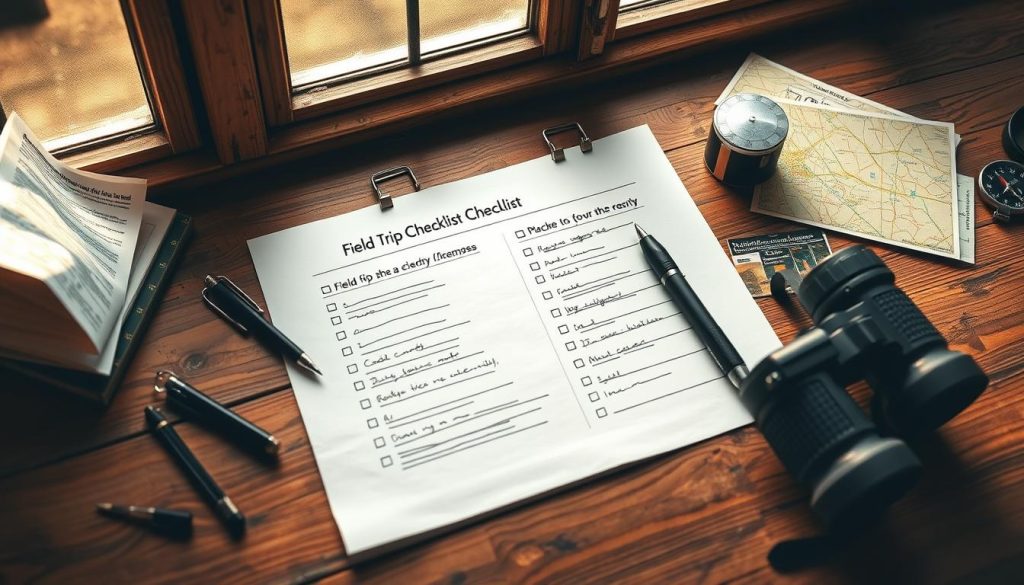What if one simple system could cut paperwork, save time, and keep students safer on every school outing?
We guide you through a step-by-step method to turn permission slips, forms, and bus lists into secure digital workflows. Our approach gives teachers and chaperones clear roles and fast access to critical information on the day of the trip.
We focus on practical tools: e-signatures, automated reminders, and mobile checklists that lower paperwork and speed approvals. You’ll learn to align trip goals to curriculum standards and involve parents with concise, multilingual updates.
On the trip itself, real-time attendance and emergency access keep teams coordinated. Afterward, quick reflection activities and thank-you notes close the loop and reinforce learning.
Key Takeaways
- Reduce paperwork by switching permission and forms to digital workflows.
- Use e-signatures and reminders to save time and speed approvals.
- Assign clear roles for teachers, chaperones, and bus coordination.
- Keep student safety first with mobile checklists and real-time attendance.
- Engage parents with short, multilingual updates.
- Use post-trip reflections to reinforce learning and community ties.
Plan and approve your field trip the right way before any paperwork goes out
Start by defining measurable learning goals so your students know what to observe and record on the visit. We align activities to standards and grade level so the outing supports classroom objectives, not just sightseeing.
Pre-visit or research the site. Collect maps, onsite rules, highlights, and the contact for the education coordinator or guide. If you can’t visit, gather background materials and prepare student prework.
- Timeline: Request admin approval 6–8 weeks ahead; submit bus and district requests at least 21 business days before the date.
- Chaperones: Choose enough adults (about 1:5), list duties responsibilities, and collect signed acknowledgements.
- Behavior & safety: Teach bus rules, site policies, and rehearse gathering signals and emergency steps.
Build a short trip checklist for permission slips, lunches, attendance lists, restroom access, and weather backups. The day before, confirm principal approval, bus arrival times, cafeteria plans, and that your guide understands your objectives.

Educational field trip documentation: the essential forms and information you need
We keep packets short and focused so you can gather consent, medical notes, and contact numbers with minimal follow-up.
Home-to-school forms: Use a permission slip that states When, Where, What, and Why. Add a clear yes/no consent line and collect emergency contact numbers and medical alerts. Send a parent permission page after approvals and a reminder the week of the trip with date, time, likely weather, schedule, and what students need bring.

Teacher and office packets
- Office info: destination, return time, teacher contact, and absent students.
- Student roster with parent numbers and allergy or medical notes.
- A concise emergency card per group with school, site, and teacher numbers.
Chaperone materials
Provide group lists, the day schedule, and clear duties responsibilities. Include a chaperone acknowledgement statement and a volunteer request page so selection is transparent.
Checklists that work: Use a trip checklist to track Name, Permission Slip, Parent Chaperone, Lunch Choice, and Payment. Date every document version and store school forms and trip paperwork together so you can find the complete field trip folder fast.
Make your field trip forms digital from start to finish
Digitize approvals and forms to keep every date, bus request, and emergency number in one visible place. We recommend a simple tool stack that combines e-signatures, secure forms, and a shared calendar so everyone sees the schedule in real time.
Build a tool stack
- E-sign platforms for permission slips and audit trails.
- Secure forms to collect sensitive medical numbers and contact data with role-based access.
- Shared calendars that show date windows, bus pickups, and site times.
Create reusable templates
Standardize a field trip checklist, permission page, chaperone request, and reminder page. Version each template and store copies on a shared drive so teachers clone and adapt without rebuilding forms.
Automate approvals and transportation
Configure alerts to submit bus requests at least 21 business days before the date. Scan completed trip forms to your coordinator three weeks prior and follow up two weeks before to confirm bus assignments.
Day-of execution and parent communications
- Use a mobile trip checklist for each group and record real-time attendance at every transition.
- Send multilingual permission slips and automated reminders the week of the trip with schedule, lunch, and weather notes.
- Store emergency contacts on phones and printed lanyards for quick access.
After the trip
Capture quick reflections, send thank-you notes to chaperones and drivers, and archive the trip checklist, trip forms, photos, and assessments in labeled folders by date.
| Process | Tool | Timing |
|---|---|---|
| Permission collection | E-sign + secure form | Open 4 weeks before date; reminders at 2 weeks |
| Bus request | Automated approval workflow | Submit 21 business days prior; confirm 14 days prior |
| Day-of management | Mobile checklist & shared calendar | Live updates during the day |
| Archiving & review | Shared drive with role permissions | Archive same day; review within one week |
Conclusion
Finish strong by turning one-off plans into a repeatable routine that saves time and reduces surprises.
When you align objectives, get approvals early, and digitize forms, every field trip becomes easier and more meaningful for students. Use the templates and processes here to keep parent notices clear, teacher tasks organized, and bus logistics confirmed without last-minute stress.
Keep a simple routine: pre-visit planning, precise packets, mobile day-of checklists, and quick post-trip reflection. This sequence makes each trip reliable and repeatable.
Whether it’s a museum or a zoo, the same framework scales. Iterate your digital forms and workflows so your school saves time and your team gains bandwidth for instruction.

Leave a Reply